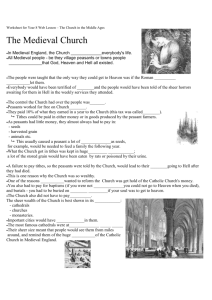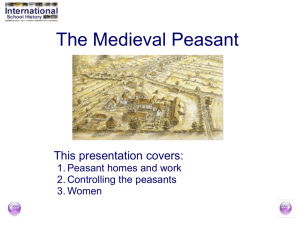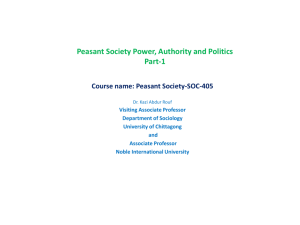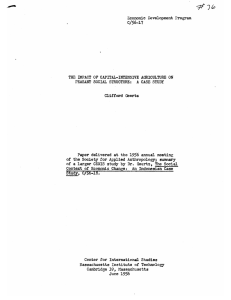Peasant Life in a Medieval Village
advertisement
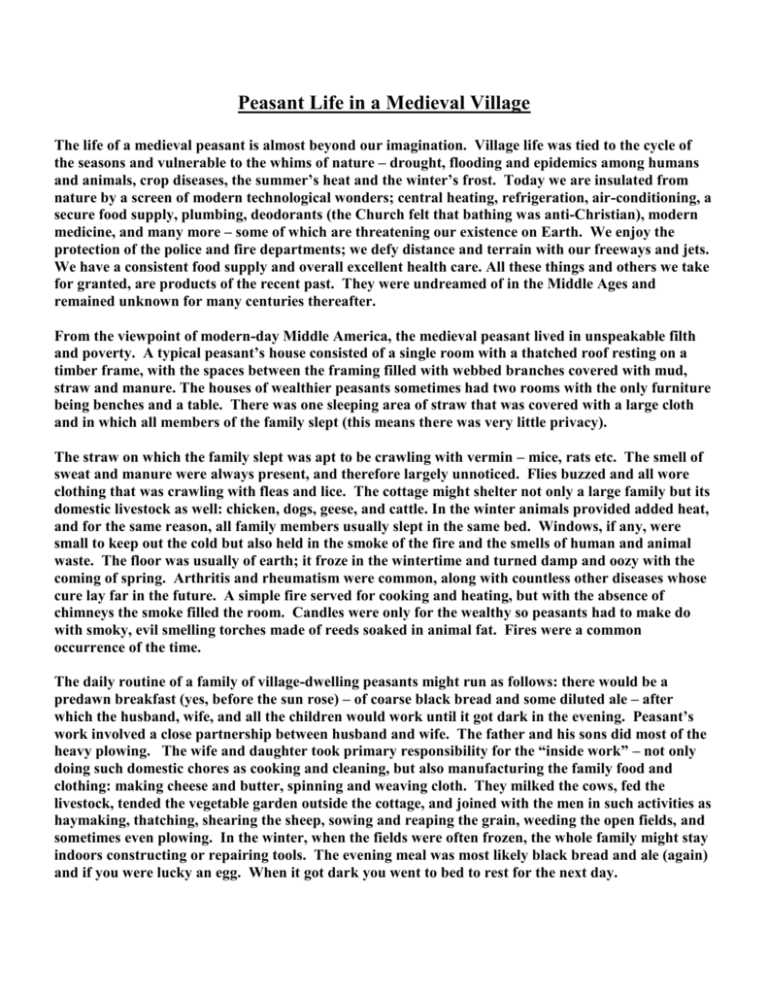
Peasant Life in a Medieval Village The life of a medieval peasant is almost beyond our imagination. Village life was tied to the cycle of the seasons and vulnerable to the whims of nature – drought, flooding and epidemics among humans and animals, crop diseases, the summer’s heat and the winter’s frost. Today we are insulated from nature by a screen of modern technological wonders; central heating, refrigeration, air-conditioning, a secure food supply, plumbing, deodorants (the Church felt that bathing was anti-Christian), modern medicine, and many more – some of which are threatening our existence on Earth. We enjoy the protection of the police and fire departments; we defy distance and terrain with our freeways and jets. We have a consistent food supply and overall excellent health care. All these things and others we take for granted, are products of the recent past. They were undreamed of in the Middle Ages and remained unknown for many centuries thereafter. From the viewpoint of modern-day Middle America, the medieval peasant lived in unspeakable filth and poverty. A typical peasant’s house consisted of a single room with a thatched roof resting on a timber frame, with the spaces between the framing filled with webbed branches covered with mud, straw and manure. The houses of wealthier peasants sometimes had two rooms with the only furniture being benches and a table. There was one sleeping area of straw that was covered with a large cloth and in which all members of the family slept (this means there was very little privacy). The straw on which the family slept was apt to be crawling with vermin – mice, rats etc. The smell of sweat and manure were always present, and therefore largely unnoticed. Flies buzzed and all wore clothing that was crawling with fleas and lice. The cottage might shelter not only a large family but its domestic livestock as well: chicken, dogs, geese, and cattle. In the winter animals provided added heat, and for the same reason, all family members usually slept in the same bed. Windows, if any, were small to keep out the cold but also held in the smoke of the fire and the smells of human and animal waste. The floor was usually of earth; it froze in the wintertime and turned damp and oozy with the coming of spring. Arthritis and rheumatism were common, along with countless other diseases whose cure lay far in the future. A simple fire served for cooking and heating, but with the absence of chimneys the smoke filled the room. Candles were only for the wealthy so peasants had to make do with smoky, evil smelling torches made of reeds soaked in animal fat. Fires were a common occurrence of the time. The daily routine of a family of village-dwelling peasants might run as follows: there would be a predawn breakfast (yes, before the sun rose) – of coarse black bread and some diluted ale – after which the husband, wife, and all the children would work until it got dark in the evening. Peasant’s work involved a close partnership between husband and wife. The father and his sons did most of the heavy plowing. The wife and daughter took primary responsibility for the “inside work” – not only doing such domestic chores as cooking and cleaning, but also manufacturing the family food and clothing: making cheese and butter, spinning and weaving cloth. They milked the cows, fed the livestock, tended the vegetable garden outside the cottage, and joined with the men in such activities as haymaking, thatching, shearing the sheep, sowing and reaping the grain, weeding the open fields, and sometimes even plowing. In the winter, when the fields were often frozen, the whole family might stay indoors constructing or repairing tools. The evening meal was most likely black bread and ale (again) and if you were lucky an egg. When it got dark you went to bed to rest for the next day. Often one or more members of the family would be immobilized by illness for which there were no medicines and no doctors. With the unsanitary conditions of the hut disease spread rapidly throughout the family. Wives endured one pregnancy after another: childbirth was a mortal danger to mother and baby alike, and infant mortality was very high. In medieval Europe approximately two-thirds of all children died before the age of ten, and well over a third during their first year. A third of all childbirths led to the death of the mother. Famine would strike a large region and destroy most of the village and any of those in close proximity of the disease. Famine and disease also affected the livestock. Worse still was the constant threat of warfare that meant that a village could be pillaged and burned. Often villages were set upon by roving bands of thieves and murderers. These criminals came to steal everything that the peasants had; often killing all the male members of the family and committing all sorts of atrocities on the female members of the family. Women would be taken captive and brought along with the group as slaves. Cattle, donkeys and flocks were taken as the village was burned to the ground. In a typical peasant village the most substantial buildings were the lord’s residence and the church. The lord’s residence was commonly surrounded by a walled enclosure that also contained a bake house, kitchen, barns and other structures. To the lord’s house, peasants would bring portions of their crops, which they owed as customary dues since they did no own the land they worked. Here too they would bring their disputes to be settled in the lord’s court, usually by ordeal or combat. The parish church often stood at the center of the village. Its priest was seldom well educated, though he might have the rudiments of reading and writing. He played a central role in the villager’s lives – baptizing infants, presiding over marriages and burials, and regularly celebrating the Mass. The church was likely to be painted inside with scenes from the Bible or the life of a local saint; such paintings provided an elementary form of religious instruction because 98% of the people of this time were illiterate. The church usually doubled as a village meeting hall, and on festival days it might be used for dancing, drinking and revelry. The feastdays of Christmas, Easter and many lesser holy days (holidays) proved joyous relief from an otherwise grinding routine. But for most of their days medieval peasant labored to raise the food that their families desperately needed to survive. As the Middle Ages progressed a change in diet occurred extending female mortality rates. Protein and iron rich foods such as pork and beans, cheese and eggs, fish and meat started to become a part of a medieval peasant’s diet. These dietary changes appear to have produced a shift of fundamental significance in the relative life expectancies of women and men. There is fairly consistent evidence that from the beginning of humanity through the Middle Ages men outnumbered and outlived women. Back in the 4th century BC, Aristotle had explained that men live longer than women do because the male is a “warmer creature than the female,” and while other classical writers differed on the explanation, they all agreed on the fact that men outlived women. Early medieval surveys disclose a preponderance of males to females, particularly in the older age groups. By the 13th and 14th centuries, however, writers were alluding to the surplus of women over men. A 13th century scholar, Albertus Magnus attributed women’s longevity to the cleansing effect of menstruation and the fact that intercourse drains the female less than the male, a clear misogynistic notion. One thing is for sure; 500-1200AD, more males than females; after 1200 AD more females than males, a statistic that holds true to today The explanation may well be found in the increased consumption of iron rich foods such as meat, beans and other green vegetables. Women require iron in much greater amounts than men. Menstruation, pregnancy, and breast feeding drain iron from the body to such a degree that a woman of menstrual age requires twice as much iron from her body and a pregnant woman requires three times as much. The scarcity of iron in the diet of common people of ancient medieval times probably resulted in many women becoming severely anemic by the early twenties and therefore highly vulnerable to death from variety of diseases. The improved diet of the later Middle Ages would have seriously reduced the high rate of female morality resulting from iron deficient anemia. The whole population would live longer and more energetic lives than ever before, but the effect of the new foods on women would be particularly striking – altering the sex ratio in women’s favor throughout European society down to the present day. Ten paragraphs – ten sentences – 30 points


